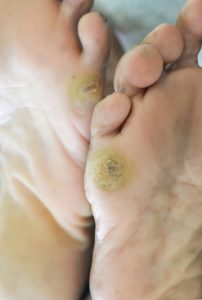Call our friendly podiatrists today on (08) 9586 3046
 Corns & calluses are thickened, yellowish plaques of skin often found in places where there is friction or pressure. Corns are smaller than calluses and often have a central core of keratin while foot callus is a more diffuse, flattened area of thick skin.
Corns & calluses are thickened, yellowish plaques of skin often found in places where there is friction or pressure. Corns are smaller than calluses and often have a central core of keratin while foot callus is a more diffuse, flattened area of thick skin.
Sometimes ‘soft’ corns may form between the toes where the skin is moist from sweat or inadequate drying. These appear white and rubbery and are also caused by excessive friction. Corns and calluses can be very painful and debilitating. Pain on weight bearing is often the chief complaint. If left untreated, they can lead to ulceration and/or infection of the affected area/s.
Almost everyone! In fact, calluses and corns affect more people than any other kind of foot problem. Some people have a natural tendency to develop calluses because of their skin type. For instance, elderly people have less fatty tissue and elasticity in their feet, people with arthritis in their feet, people who work in occupations that require them to spend a lot of time on their feet, and people with dry skin.